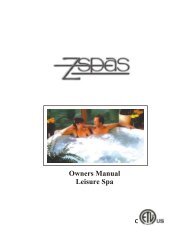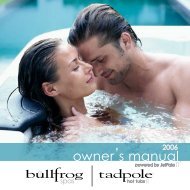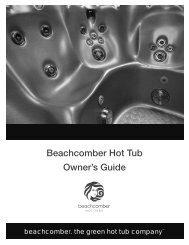Tiger Spas
2003 - All Seasons Spa
2003 - All Seasons Spa
Create successful ePaper yourself
Turn your PDF publications into a flip-book with our unique Google optimized e-Paper software.
Answer: There are two types of chlorine in your spa. The first is the Free Available Chlorine, which is the chlorine available to sanitize your spa.<br />
This available free chlorine does not have an odor. The second is Chloramine, which is residue from chlorine already expended. Chloramines have<br />
a strong chlorine odor. The smell from Chloramines can be eliminated by “shocking” the water. If you smell chlorine in the water, your spa is<br />
reminding you to add a shock treatment.<br />
Question: Why can’t I fill my spa with soft water?<br />
Answer: Soft water is essentially the same as regular water except that most or all of the calcium has been replaced by sodium. Soft water may<br />
be corrosive to the heater and other components. Replacement of spa components damaged by soft water is extremely expensive.<br />
Question: I am trying to reduce the number of chemicals to which my family is exposed. Do I really need to use so many chemicals and in such<br />
large amounts?<br />
Answer: While over-exposure to any chemical can be unhealthful, many low levels of chemicals are effective and beneficial. In the case of spa<br />
water, the chemicals recommended in the <strong>Tiger</strong> River ® Water Maintenance Program are needed to protect the user from water-borne pathogens<br />
(disease-causing microbes) and to prevent corrosion of spa components. The EverFresh ® water care system minimizes the use of chemicals with<br />
harsh side effects, such as halogen sanitizers.<br />
Question: Why isn’t water chemistry damage covered by the warranty?<br />
Answer: The chemical levels and water quality of the water in the spa are under your direct control. With proper basic care, the spa will provide<br />
many years of hot water relaxation. If you are unsure about any chemical or its usage in the spa, contact your Authorized Dealer, or Watkins<br />
Manufacturing Corporation.<br />
WATER TERMINOLOGY<br />
The following chemical terms are used in this Water Quality and Maintenance section. Understanding their meaning will help you to better<br />
understand the water maintenance process.<br />
Bromamines: Compounds formed when bromine combines with nitrogen from body oils, urine, perspiration, etc. Unlike chloramines,<br />
bromamines have no pungent odor, and are effective sanitizers.<br />
Bromine: A halogen sanitizer (in the same chemical family as chlorine). Bromine is commonly used in stick, tablet, or granular form. See the DO’s<br />
and DON’Ts of Spa Water Maintenance for additional information.<br />
Calcium Hardness: The amount of dissolved calcium in the spa water. This should be approximately 150-200 ppm. High levels of calcium can<br />
cause cloudy water and scaling. Low levels can cause harm to the spa equipment.<br />
Chloramines: Compounds formed when chlorine combines with nitrogen from body oils, urine, perspiration, etc. Chloramines can cause eye<br />
irritation as well as having a strong odor. Unlike bromamines, chloramines are weaker, slower sanitizers.<br />
Chlorine: An efficient sanitizing chemical for spas. Watkins Manufacturing Corporation recommends the use of sodium dichlor-type granulated<br />
chlorine. This type is preferred because it is totally soluble and nearly pH neutral.<br />
Chlorine (or Bromine) Residual: The amount of chlorine or bromine remaining after chlorine or bromine demand has been satisfied. The residual<br />
is, therefore, the amount of sanitizer which is chemically available to kill bacteria, viruses and algae.<br />
Corrosion: The gradual wearing away of metal spa parts, usually caused by chemical action. Generally, corrosion is caused by low pH or by water<br />
with levels of TA, CH, pH or sanitizer which are outside the recommended ranges.<br />
DPD: The preferred reagent used in test kits to measure the Free Available Chlorine.<br />
Halogen: Any one of these five elements: fluorine, chlorine, bromine, iodine, and astatine.<br />
MPS: Monopersulfate is the non-chlorine oxidizer used with the FreshWater Ag +® silver ion purification system.<br />
Nitric Acid: The formulation of nitric acid, a highly corrosive chemical, is a byproduct of the ozone generating process. Nitric acid is produced in<br />
very small quantities and is readily dissolved in the water stream with ozone.<br />
Oxidizer: The use of an oxidizing chemical is to prevent the buildup of contaminants, maximize sanitizer efficiency, minimize combined chlorine<br />
and improve water clarity.<br />
Ozone: Ozone is a powerful oxidizing agent which is produced in nature and artificially by man. Ozone forms no byproducts of chloramines (ozone<br />
actually oxidizes chloramines) and will not alter the water’s pH.<br />
Pathogen: A microorganism such as bacterium that cause disease.<br />
pH: The measure of the spa water’s acidity and alkalinity. The recommended pH for the spa water is 7.4 to 7.6. Below 7.0 (considered neutral), the<br />
spa water is too acidic and can damage the heating system. Above 7.8, the water is too alkaline and can result in cloudy water, and scale<br />
formation on the shell and heater.<br />
ppm: The abbreviation of “parts per million”, the standard measurement of chemical concentration in water. Identical to mg/l (milligrams per liter).<br />
Reagent: A chemical material in liquid, powder, or tablet form for use in chemical testing.<br />
Sanitizer: Sanitizers are added and maintained at recommended residuals to protect bathers against pathogenic organisms which can cause<br />
disease and infection in spa water.<br />
Water Quality and Maintenance<br />
Page 43
















